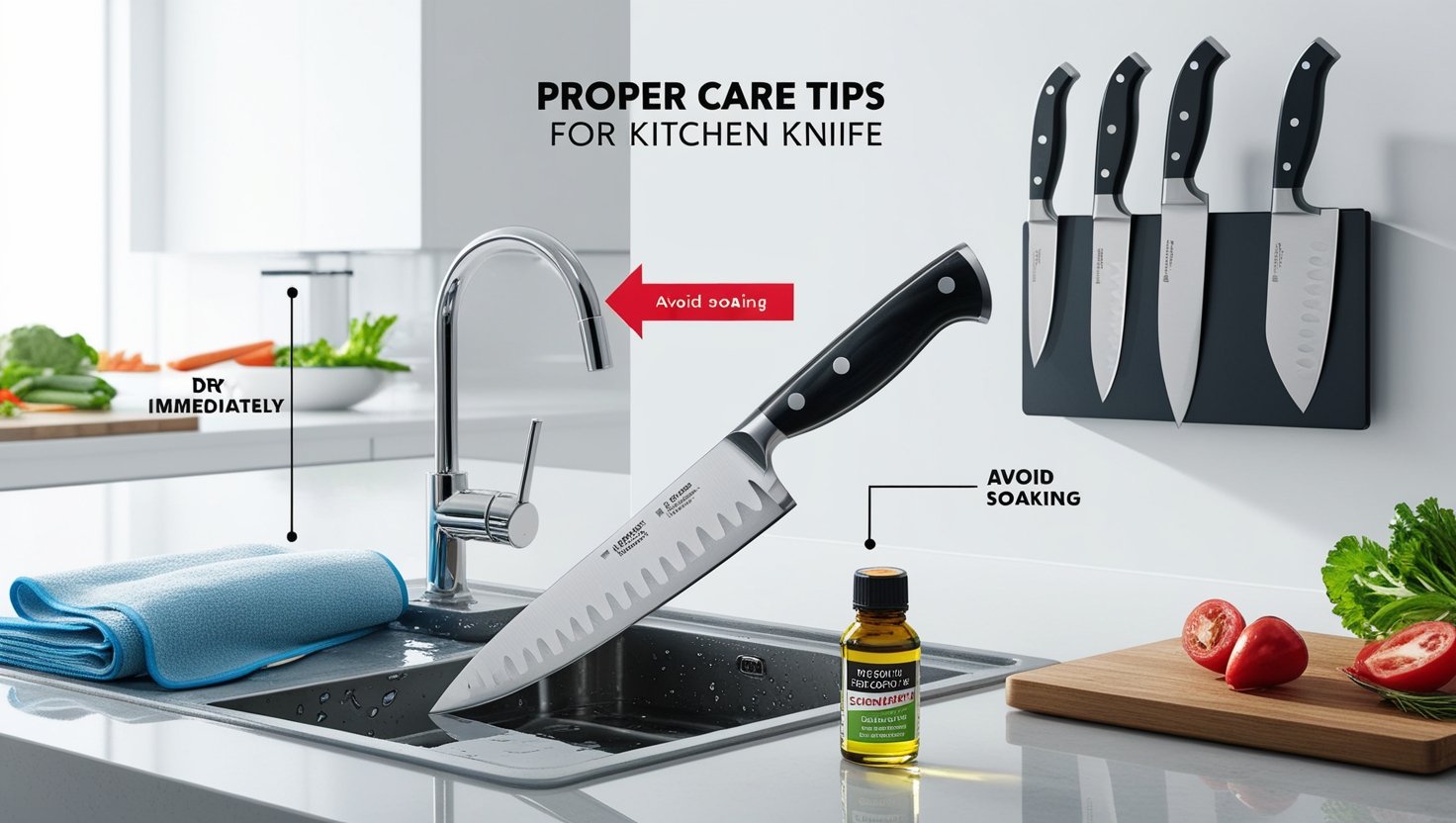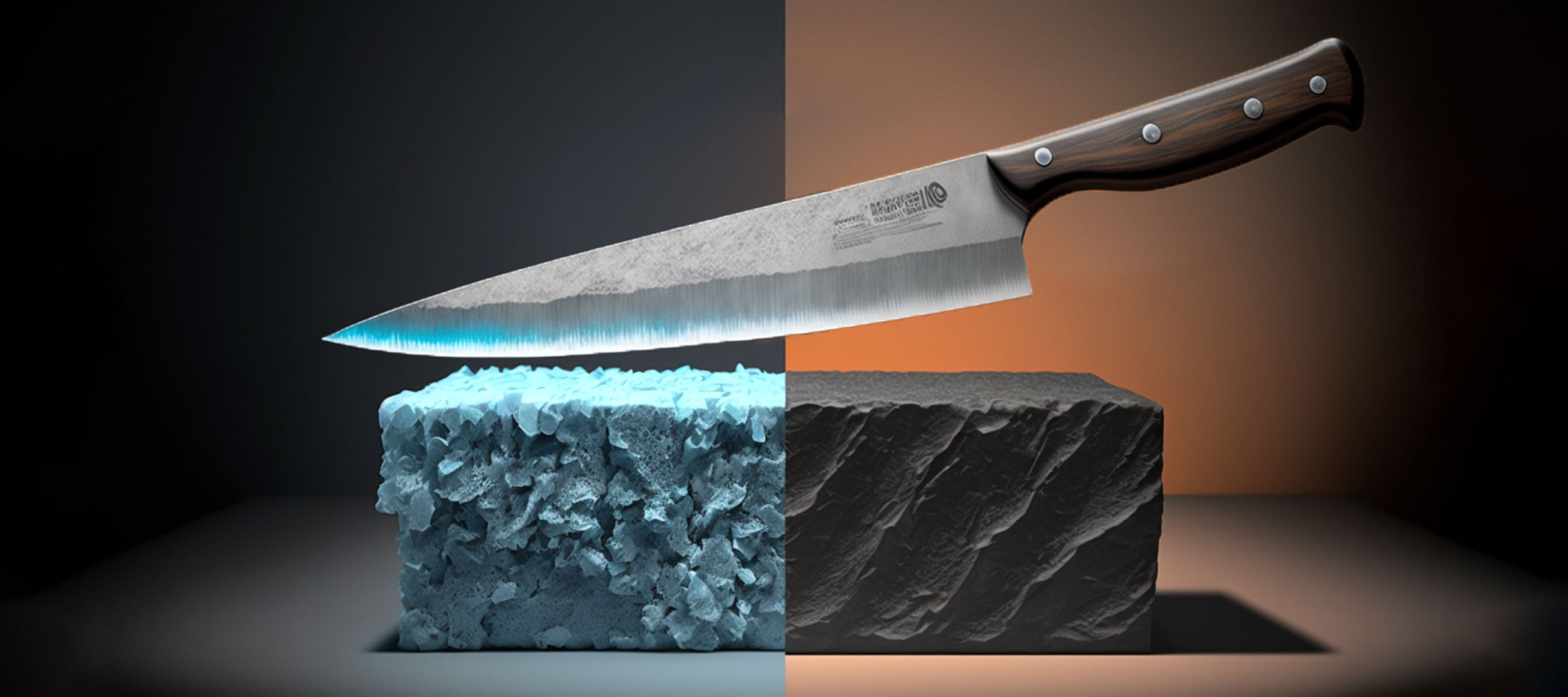A kitchen knife should not stay wet for long. Keeping it wet can cause rust.
It can also dull the blade faster. Water and metal are not best friends. This is especially true for kitchen knives. If you leave a knife wet, it can develop rust spots. These spots can weaken the blade and make it less sharp.
To keep your kitchen knives in top shape, dry them after washing. This simple step can extend the life of your knives and ensure they stay sharp and safe to use. Here, we discussed why keeping your kitchen knives dry is vital and how to care for them properly. So, learn more about maintaining your kitchen tools.

Introduction To Kitchen Knife Maintenance
Keeping a kitchen knife wet for long periods can cause rust and damage. Dry it immediately after washing to maintain its sharpness and durability. Proper knife care ensures a longer lifespan and better performance in the kitchen.
Proper kitchen knife maintenance is crucial for every cook. A well-maintained knife ensures safety and efficiency. It also extends the life of your knife. Understanding how to care for your knife can save you time and money. Maintaining a kitchen knife involves several steps. Cleaning, drying, and storing the knife correctly are key. This blog post will guide you through the essentials of kitchen knife care.
Importance Of Proper Care
Proper care keeps your knife sharp, making cutting easier and safer. Dull blades can slip and cause accidents. Regular maintenance also prevents rust and corrosion. A well-cared-for knife can last many years, retaining its edge and performing better. Proper care is an investment in your kitchen tools.
Common Myths
Many myths surround kitchen knife care. One common myth is that knives can be left wet. This is false. Leaving a knife wet can cause rust and damage. Another myth is that dishwashers are safe for knives. This is not true. Dishwashers can dull and damage blades.
Hand washing is best for your knives. Some people think any cutting board is OK. Hard surfaces like glass can damage your knife. Use wooden or plastic boards instead. Understanding these myths can help you maintain your knives better. Proper care and handling ensure your knives stay in top shape. “`
Impact Of Water On Kitchen Knives
Water can have a significant impact on kitchen knives. Exposure to water can damage the blade and affect its performance. Understanding these effects can help you maintain your knives better.
Rust And Corrosion
Rust and corrosion occur when metal reacts with water. This reaction can deteriorate your knife’s blade. Even high-quality stainless steel knives can rust if left wet. Rust can weaken the blade and lead to breakage. It can also make the knife unsafe for food preparation.
Blade Dulling
Water can also dull a knife’s blade. A wet blade may lose its sharpness faster, and water can soften the edge, making it less effective for cutting. Regular drying can help maintain the blade’s sharpness. Keeping your knife dry ensures it stays sharp longer.
Factors Influencing Knife Durability
Understanding how long a kitchen knife can stay wet without damage is key. Several factors influence knife durability, determining how well a knife withstands moisture and remains sharp. Let’s explore the key elements that affect a knife’s durability.
Material Composition
The material of the knife blade plays a crucial role. Knives are made from stainless steel, carbon steel, and ceramic materials. Stainless steel resists rust better than carbon steel. Carbon steel blades, while sharp, rust quickly if left wet. Ceramic knives resist rust but can chip easily. Knowing the blade material helps you care for your knife better.
Knife Construction
The construction of the knife also matters. A full tang knife, where the blade extends into the handle, offers better balance and strength. This type of knife is less likely to break. Knives with riveted handles provide added durability. Proper construction ensures that the knife withstands regular use and exposure to moisture. The quality of the knife’s finish can also impact its durability. A well-polished blade resists water and rusts better.

Credit: redfinz.com
Safe Practices For Wet Knives
Maintaining kitchen knives involves more than sharpening them. Safe handling practices for wet knives ensure their longevity and your safety. Wet knives can become rusty, dull, and dangerous if not handled correctly.
Immediate Drying
Dry your kitchen knife right after washing. Use a clean, dry towel. Water on the blade can lead to rust. Rust weakens the metal and makes the knife unsafe.
Wipe both sides of the blade. Also, pay attention to the handle. If it remains wet, it can become slippery, increasing the risk of accidents.
Ensure no water remains on the knife. Even tiny drops can cause damage over time. Immediate drying helps maintain the knife’s edge and prevents rust.
Proper Storage
Store your kitchen knife in a dry place. Avoid leaving it in the sink or on a wet countertop. Water can seep into small cracks and crevices, causing rust.
Use a knife block, magnetic strip, or knife sheath. These storage options keep your knife dry and protected. Proper storage also prevents accidental cuts when reaching for the knife.
Avoid storing your knife with other utensils. Contact with other metals can cause scratches and dull the blade. Keep your knife separate to maintain its sharpness.
Ensure the storage area is clean and dry. Check for moisture regularly and clean the area. This practice helps keep your knife in excellent condition.
Cleaning Techniques
Keeping your kitchen knife clean is essential for its longevity. Proper cleaning techniques prevent rust and maintain sharpness. Hand washing and dishwashing are standard methods, but each has risks and benefits. Understanding these techniques will help you choose your kitchen knives best.
Hand Washing Tips
Hand washing is often the safest method for cleaning kitchen knives. Follow these tips:
- Use warm, soapy water.
- Wash the blade carefully to avoid cuts.
- Rinse the knife thoroughly to remove the soap.
- Dry the knife immediately with a clean towel.
Never soak your knife in water. Prolonged exposure can lead to rust. Hand washing ensures you have control over the knife’s cleanliness and condition.
Dishwasher Risks
While dishwashers offer convenience, they pose risks for kitchen knives:
| Risk | Explanation |
|---|---|
| Blade Damage | Knives can knock against other items, causing nicks. |
| Rust | Moisture and heat can cause rust spots. |
| Handle Damage | Dishwasher detergent can degrade handle materials. |
Hand washing is often recommended for maintaining knife quality. If you use a dishwasher, ensure the knife is secure and avoid harsh detergents.
Preventative Measures
To keep your kitchen knives in top condition, avoid leaving them wet. Prolonged exposure to moisture can cause rust and corrosion, which affects the knife’s appearance and performance. You can protect your knives and extend their lifespan by taking preventative measures.
Use Of Protective Coatings
Applying a protective coating to your knives can be very beneficial. Protective coatings act as a barrier against moisture and air. This helps prevent rust and corrosion. Common types of protective coatings include:
- Food-grade mineral oil
- Beeswax
- Special knife oils
Use a coating that is safe for food contact. Apply the coating regularly to ensure maximum protection. For the best results, always follow the manufacturer’s instructions.
Regular Maintenance
Regular maintenance is key to keeping your knives in excellent condition. This includes proper cleaning, drying, and storage. After each use, wash your knife with warm, soapy water. Avoid using the dishwasher as it can cause damage.
Dry your knife thoroughly with a clean towel. Leaving it wet can cause rust. Use a knife block, magnetic strip, or blade guard for optimal storage. These will protect the blade from moisture and reduce the risk of damage.
Perform regular inspections of your knives. Look for signs of rust or damage. If you notice any issues, address them immediately. Sharpen your knives regularly to maintain their edge and functionality.
| Maintenance Task | Frequency |
|---|---|
| Clean and Dry | After Every Use |
| Apply Protective Coating | Weekly or As Needed |
| Inspect for Rust or Damage | Monthly |
| Sharpen | Every Few Months |
Following these preventative measures ensures your kitchen knives remain sharp, safe, and effective. Proper care and maintenance will help you get the most out of your investment.
Signs Of Knife Damage
Identifying signs of knife damage can be crucial. They help maintain the efficiency and safety of your kitchen tools. A wet kitchen knife may lead to various issues. Understanding these signs can prevent further damage and ensure your knife lasts longer.
Visual Inspection
Inspect the blade for rust spots, which are clear indicators of moisture damage. Check for discoloration or stains on the metal, which can weaken the blade over time. Look at the knife’s edge, and notice any chips or nicks. These can affect the knife’s cutting performance.
Performance Issues
A wet knife might not cut as smoothly. You may feel more resistance while slicing. The knife could also become dull quicker. This means frequent sharpening is needed. A damaged handle is another sign. It might feel loose or wobbly. This can make the knife unsafe to use.

Credit: www.instagram.com
Restoring A Damaged Knife
A wet kitchen knife can quickly become damaged. Restoring it to its original state is essential for safety and performance. Whether the damage is due to rust, dullness, or chips, there are effective methods for bringing the knife back to life.
Sharpening Methods
There are several sharpening methods to restore your knife’s edge:
- Whetstone: This is the traditional method. It involves using a stone with water or oil to grind the blade.
- Honing Rod: Ideal for regular maintenance. It keeps the blade straight and sharp.
- Electric Sharpener: These devices offer quick and consistent results. They are easy to use.
A whetstone requires patience and practice, but it can produce a razor-sharp edge. A honing rod keeps the knife in shape between serious sharpening sessions. Electric sharpeners are convenient for those who need a quick fix without much effort.
Professional Services
Sometimes, a knife is too damaged for DIY sharpening. Professional services are the best option.
Professional sharpeners can handle severe damage. They use advanced techniques and tools. Here’s what you can expect:
| Service | Description |
|---|---|
| Edge Restoration | Fixes chips and restores the blade to its original sharpness. |
| Rust Removal | Eliminates rust and prevents further corrosion. |
| Polishing | Enhances the blade’s appearance and smoothness. |
Using professional services ensures your knife is restored correctly. It can prolong the life of your knife. It also saves you time and effort.

Credit: santokuknives.co.uk
Frequently Asked Questions
How Long Can A Kitchen Knife Stay Wet?
A kitchen knife should not stay wet for more than a few minutes. Prolonged exposure to moisture can cause rust and corrosion. Always dry your knife immediately after washing.
Can Leaving A Knife Wet Cause Rust?
Yes, leaving a knife wet can cause rust. Rust forms when the blade is exposed to moisture. To prevent rust, always dry your knife immediately after washing.
Is It Safe To Leave Knives Wet Overnight?
No, it is not safe to leave knives wet overnight. Moisture can damage the blade and handle. To maintain their condition, always dry knives thoroughly after use.
How Do You Dry A Kitchen Knife Properly?
To dry a kitchen knife properly, use a clean, dry cloth. Gently wipe the blade and handle, ensuring no moisture remains on the knife before storing it.
Maintenance Tips
A wet kitchen knife can lead to rust and dullness. Dry knives immediately after washing and store them in a dry place. This ensures longevity and safety. Remember, proper care extends a knife’s life. Your knife will stay sharp and ready for use.


